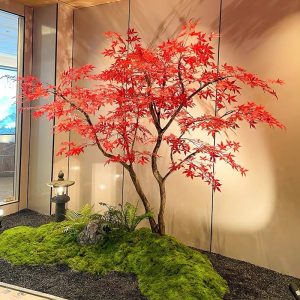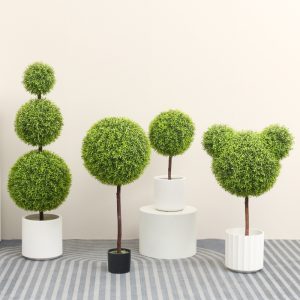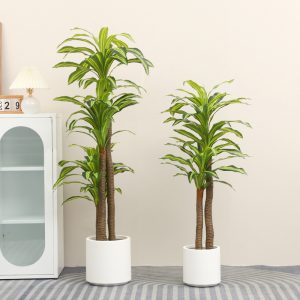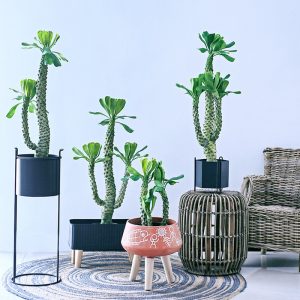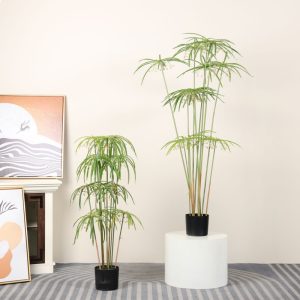Having worked in the artificial plant industry for many years, I’ve observed an interesting phenomenon: some artificial plants last seven or eight years in great condition, while others start to look worn out after just one or two years. The difference isn’t because the plants themselves are inferior—it’s mainly due to whether or not the owner has the habit of performing regular checkups! Our customer data clearly shows that users who perform regular checkups can extend the life of their artificial plants by an average of 62%, while keeping them looking over 80% new. Today, I’ll share checkup techniques and experience to help your plants “live” longer with simple maintenance.
1. Don’t Overlook It! Regular Checkups Can Save You (and Your Wallet)
Many people think once artificial plants are purchased, they don’t need any maintenance, but in fact, dust, moisture, sunlight, etc., are the “invisible killers” of artificial plants:
- Dust accumulation in leaf crevices, if not cleaned every three months, especially in humid environments, can lead to mold growth and insect infestations.
- Adhesive joints can loosen under high temperatures after being exposed for six months.
- In direct sunlight, materials may fade by 0.3% each month. While this may seem insignificant, it leads to noticeable color deterioration after a year.
Regular checkups are like giving your artificial plants a “physical exam,” spotting small issues early and avoiding larger damage later. Experience analysis shows that spending 1 hour on a checkup saves 5 hours of repair time and prevents 70% of “irreparable” damage.
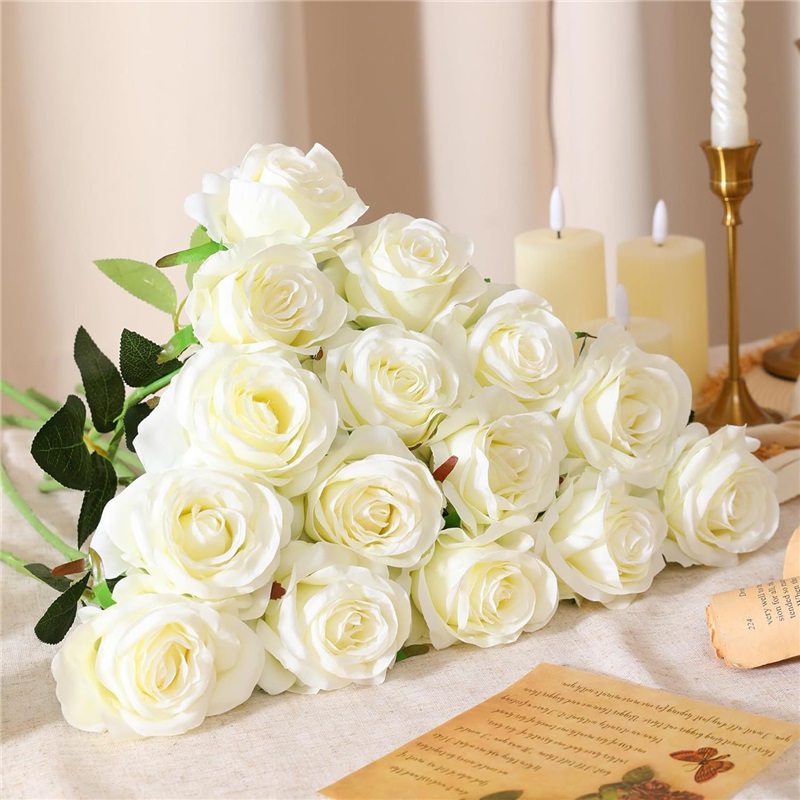
2. How Often Should You Check? It Depends on Where They “Live”!
Basic Checkup (For Everyone)
Frequency: Once a week, about 5-10 minutes
What to Check:
- Is there a lot of dust on the leaves?
- Are the leaves leaning or crooked?
- Is the pot stable?
Tools:
- White gloves (helps you see dust easily)
- Small flashlight (shine light on the back of leaves and in crevices to spot hidden dust)
In-Depth Checkup (For More Challenging Environments)
- High-Risk Areas: Direct sunlight, high humidity, frequent handling. Check every 2 weeks for 15-20 minutes. Typical places: South-facing windowsills, bathrooms, shopping mall walkways, children’s rooms.
- Medium-Risk Areas: Regular indoor spaces, occasional handling. Check once a month for 10-15 minutes. Typical places: Living room corners, office cubicles.
- Low-Risk Areas: Display cabinets, high shelves, infrequently touched. Check once every 3 months, 10 minutes is enough. Typical places: Display cases, top of bookshelves.
3. What to Check? A Step-by-Step Guide
Appearance Integrity
Leaves/Flowers:
- Look for cracks: Focus on the edges of PVC leaves and the seams of fabric flowers.
- Check for fading: Take photos of the plants each month and compare to spot any subtle changes.
- Look for deformation: PE leaves often curl, and silicone petals may flatten.
Branches/Trunk:
- Shake it: Gently shake the branches. If they move more than 30 degrees, the connection might be loose.
- Feel the texture: For PU tree bark, if the surface is peeling or becomes smooth, there might be an issue.
Pot/Base:
- Is it stable? Lift the top of the plant and check if the base is stable. If it tilts more than 5 degrees, it needs reinforcing.
- Check drainage: Inspect the bottom of the faux soil to make sure the drainage hole isn’t clogged. Clogs can cause bacterial buildup.
Material Condition
PVC/PE:
- Gently scratch the surface with your nail—if it leaves a white mark that doesn’t disappear after 10 seconds, it’s starting to age.
- Fold the leaf 180 degrees and release it. If it doesn’t return to its original shape, it indicates reduced flexibility.
Fabric/Paper:
- Check for pilling or snags, especially in areas where children frequently touch.
- Squeeze the petals—if they feel hard, moisture has likely invaded.
Silicone/PU:
- If the surface feels sticky, it’s a sign that high temperatures have caused aging.
- Check the root connections of the leaves for black or green spots, which could be mold.
Connection Points (Most Critical)
- Leaf to Stem: Gently pull the leaf with tweezers. If it loosens, reinforce immediately! 90% of leaf drops happen because early loosening wasn’t addressed.
- Branch to Trunk: Check if the wrapped tape is cracked or brittle.
- Small Parts (like faux fruits or flowers): Shake them individually to ensure nothing is loose. If anything is loose, glue it down immediately.
4. Found a Problem? Don’t Panic! Handle It in Stages
Small Issues (Easy Fixes):
- Dust Accumulation: Clean according to the material type (refer to the maintenance guide).
- Slight Loosening: Use hot melt glue for PVC/PE; silicone-specific glue for silicone; fabric glue for fabric plants.
- Small Fading: Small plants can have individual leaves replaced; larger plants can be touched up with acrylic paint.
Moderate Issues (Requires Some Effort):
- Multiple Loose Parts: Disassemble and reassemble, replacing old plastic clips with stainless steel screws for durability.
- Material Aging: Spray with UV-protective coating to extend the plant’s lifespan by 1-2 years.
- Deformation: Use a low-temperature blow dryer to soften the deformed area, then correct it while hot and press into shape with a heavy object.
Big Issues (Replace It):
- If repair costs exceed half the cost of buying a new plant (e.g., broken main trunk of a large plant), replace it.
- If there’s a safety risk (e.g., exposed wires or severely unstable base), remove it immediately for safety.
5. Must-Have Tools for Checkups
- High-Powered Flashlight ($5-$15): To illuminate the back of leaves and check for dust and small cracks.
- Macro Lens for Phone Camera ($10-$30): Helps check for fine cracks and color fading (optional but useful).
- Mini Hygrometer ($8-$20): Place near plants to monitor humidity levels, strongly recommended for humid environments.
- Small Angle Measuring Tool ($15-$30): Measures tilt and leaf angles, useful for large plants (optional).
- Checkup Record Sheet (Free): Record the date of each checkup, issues found, and how they were handled. Highly recommended!
6. Avoid These Pitfalls in Your Checkup Habits
- Only Check the Front: The back of the leaves and the inner sides of branches often have the most dust and aging, so always check there too!
- Just Relying on the Naked Eye to Spot Fading? No! Take a photo every month and compare. Using a black-and-white filter on your phone makes it easier to spot color differences.
- Scrubbing Too Hard? Overzealous scrubbing may damage fabric and paper materials. The right method is to use a soft brush to gently remove dust.
- Ignoring Seasonal Changes: During summer and autumn, temperature and humidity changes can accelerate aging. Increase checkup frequency during season changes.
Feedback from Real-Life Experience:
We tracked 500 households with artificial plants and found that families who consistently performed “check – record – handle” maintenance reduced their annual maintenance costs by 42% and kept their plants looking over 8/10. Those who skipped checkups had an average rating of only 5.5/10, a noticeable difference.
Summary:
Regular checkups are not just a tedious task—they are a smart way to ensure your artificial plants stay beautiful and durable for years. Developing the habit of checking once a week will keep them in optimal condition. If you run into issues during a checkup (like material aging or complex designs), feel free to send me pictures, and I’ll help you find the best solutions.








